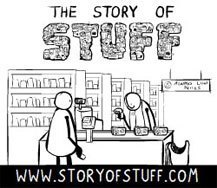Stuart Jeanne Bramhall's Blog: The Most Revolutionary Act , page 1380
October 5, 2013
Solutions: Taking Back Our Power
Nothing like a nice government shutdown to remind us that the federal government is hopelessly dysfunctional. Congress and the White House are so focused on the needs of their corporate donors that most of the laws they pass hurt ordinary Americans rather than helping them. Fortunately a growing number of local groups have discovered that the most meaningful form of political change happens outside of official political channels. Together with family, friends, and neighbors, they’re opting out of the “corporate” lifestyle and inventing more meaningful grassroots models for meeting human needs.
The Story of Solutions
Annie Leonard, who produced the world changing video They Story of Stuff in 2008, has just released a sequel The Story of Solutions. Like her first film, it challenges a society built on ever increasing economic growth and accumulating more stuff. However the focus of The Story of Solutions is more on community organizing to move our economy in a more sustainable and just direction. To quote from the film promo:
“In the current ‘Game of More’, we’re told to cheer a growing economy – more roads, more malls, more Stuff! – even though our health indicators are worsening, income inequality is growing and polar icecaps are melting. But what if we changed the point of the game? What if the goal of our economy wasn’t more, but better – better health, better jobs and a better chance to survive on the planet?”
The nine-minute video includes inspiring real-world examples of ways in which communities are mobilizing for change – through programs as simple as “tool-sharing” libraries. There’s absolutely no reason why every American needs to own their own lawnmower, power drill, and chainsaw.
Here’s the original The Story of Stuff for people who missed it when it first came out.
photo credit: net_efekt via photopin cc


October 3, 2013
Books to Prisoners

Books to Prisoners is a Seattle-based, all-volunteer non-profit organization founded in 1973 under the sponsorship of Left Bank Books. BTP ships books to prisoners – at their request. Prisoners send them 1,200 – 1,300 book requests per month. BTP believes that books are important tools for learning and self-improvement. Moreover, as Brazilian educator and activist Paulo Freire taught, literacy and reading opens peoples’ minds to new ideas and possibilities.
In the US, which spends vastly more on the prison industrial complex than schools, prison is the primary anti-poverty program. American prisons house nearly 25% of the world’s prisoners – more than 2.2 million. The vast majority are from disadvantaged communities and are either African American or Hispanic. Most have been incarcerated for victimless drug crimes. Prison rehabilitation is a myth, especially as prison privatization and state cutbacks have greatly curtailed prisoners’ access educational and training opportunities.
BTP prefers monetary donations. However they do welcome books from the following categories provided they are in paperback (most prisons prohibit hard back books) – and preferably accompanied with a $35-70 donation to cover the cost of shipping them to prisons.
Dictionaries
Antiquarian books (these can be sold to cover postage)
Spanish books
Legal self-help
Almanacs
Books on chess
Books on drawing
Vocational education
How-to Books
Textbooks
GED preparation books
African-American history
True crime
Paperback fiction: thrillers, mysteries, sci-fi, Westerns, fantasy, horror
Books (and donations) can be mailed to:
Books to Prisoners, c/o Left Bank Books, 92 Pike St. Box A, Seattle WA 98101
People can also donate via the BTP website: http://www.bookstoprisoners.net/donate/
The following video illustrates the profound effect this forty-year program has had on prisoners’ lives:
I have often reflected upon the new vistas that reading opened to me. I knew right there in prison that reading had changed forever the course of my life. As I see it today, the ability to read awoke in me some long dormant craving to be mentally alive – Malcolm X
photo credit: » Zitona « via photopin cc
Originally posted at Veterans Today
Books to Prisoners

Books to Prisoners is a Seattle-based, all-volunteer non-profit organization founded in 1973 under the sponsorship of Left Bank Books. BTP ships books to prisoners – at their request. Prisoners send them 1,200 – 1,300 book requests per month. BTP believes that books are important tools for learning and self-improvement. Moreover, as Brazilian educator and activist Paulo Freire taught, literacy and reading opens peoples’ minds to new ideas and possibilities.
In the US, which spends vastly more on the prison industrial complex than schools, prison is the primary anti-poverty program. American prisons house nearly 25% of the world’s prisoners – more than 2.2 million. The vast majority are from disadvantaged communities and are either African American or Hispanic. Most have been incarcerated for victimless drug crimes. Prison rehabilitation is a myth, especially as prison privatization and state cutbacks have greatly curtailed prisoners’ access educational and training opportunities.
BTP prefers monetary donations. However they do welcome books from the following categories provided they are in paperback (most prisons prohibit hard back books) – and preferably accompanied with a $35-70 donation to cover the cost of shipping them to prisons.
Dictionaries
Antiquarian books (these can be sold to cover postage)
Spanish books
Legal self-help
Almanacs
Books on chess
Books on drawing
Vocational education
How-to Books
Textbooks
GED preparation books
African-American history
True crime
Paperback fiction: thrillers, mysteries, sci-fi, Westerns, fantasy, horror
Books (and donations) can be mailed to:
Books to Prisoners, c/o Left Bank Books, 92 Pike St. Box A, Seattle WA 98101
People can also donate via the BTP website: http://www.bookstoprisoners.net/donate/
The following video illustrates the profound effect this forty-year program has had on prisoners’ lives:
I have often reflected upon the new vistas that reading opened to me. I knew right there in prison that reading had changed forever the course of my life. As I see it today, the ability to read awoke in me some long dormant craving to be mentally alive – Malcolm X
photo credit: » Zitona « via photopin cc
Originally posted at Veterans Today
October 1, 2013
Where Women Rule

Below is a recent CCTV-English (Chinese state TV) documentary on low carbon development in Rwanda. It piqued my interest, mainly because Rwanda has the only parliament in the world where women are in the majority. Following recent elections*, women hold 56.3% of the seats. Former rebel leader Paul Kagame, credited with ending the Rwandan genocide, was re-elected president.
Rwanda, which also has the highest population density in Africa, was left in ruins by the brutal 1994 genocide, in which Hutu extremists butchered a million members of the Tutsi minority. The genocide ended when the Hutu government was overturned by RPF (Tutsi) rebels led by Kagame.
Although the Rwandan economy was virtually destroyed by the civil war, substantial Chinese investment has made it one of the fastest growing economies in Africa. Determined to end their dependence on foreign investment and imports, the Rwandan government has joined Korea, Denmark, and China in centering development around a low carbon economy.
Investing in Distributed and Renewable Energy
For example, instead of investing millions of dollars in an electrical grid to supply the countryside, the government is assisting rural villages in developing distributed (i.e. grid-less) energy systems. To reduce their reliance on expensive fossil fuel imports, they’re assisting villager to produce their own power with solar panels, mini-hydroelectric generators**, and methane cogeneration systems***. They have also reduced national reliance on food imports by terracing and replanting hillsides that have been devastated by deforestation and landslides. (Wouldn’t it be great if the Obama administration subsidized distributed energy systems and reforestation – instead of defense contractors and oil, pharmaceutical and insurance companies?)
Exactly How “Free” is Rwanda?
Kagame’s zero tolerance for corruption is believed to be an essential factor in Rwanda’s phenomenal economic growth. However his critics complain that economic growth and security have come at the expense of freedom of expression. Although Rwanda has a constitution and holds regular elections, human rights groups raise legitimate concerns about restrictions Kagame places on opposition parties.
The clampdown on opposition groups seems to be a direct response to periodic bombings and sniper attacks by a rebel group called the Democratic Forces for the Liberation of Rwanda (FDLR). The FDLR, which operates from across the border in the Democratic Republic of Congo, includes remnants of the Hutu militia responsible for the 1994 genocide.
A 2009 UN Report reveals the FDLR is funded by a vast international network of Spanish charities, Ukrainian arms dealers, corrupt African officials, secret North Korean weapon suppliers, Indian gold dealers, and officials of the United Arab Emirates. This motley assortment of wheeler-dealers supply the FDLR arms in return for illicit Congolese gold and other minerals.
Parallels with Syria
Ironically Kagame’s situation is very similar that that of Syrian president Bashar al-Assad. Tutsis comprise 15% of the population, and Hutus 85%. A Tutsi monarch ruled Rwanda at the time of colonization, with the French institutionalizing Tutsi oppression with the colonial government they established. This would lead to deep-seated resentments resulting in the Hutu rebellion and genocide.
*In the Sept 13 election, there was a 98.8% turnout and Kagame won 76% of the vote.
**A friend of my manufactures PowerSpout mini-hydrogenerators (he made the first one out of old washing machine parts). Conventional hydropower depends on dams, which cause massive environmental and ecosystem destruction. All you need for mini-hydroelectric generation is a stream that flows downhill.
***A methane co-generation system converts methane from plant, animal, and/or human wastes to heat and power.
Enjoy.
photo credit: Gates Foundation via photopin cc
September 29, 2013
TV3 Tackles Income Inequality
Although it first aired on commercial TV, the New Zealand documentary Mind the Gap reminds me a lot of the PBS documentaries I used to watch on Friday night in the late seventies. It dissects the alarming rate at which New Zealand’s wealthy elite are sucking up wealth from our working class families.
While New Zealand’s political and economic dynamics are somewhat different from those of the US, there are common factors at play. Moreover the New Zealand economy is somewhat easier to unpack. In addition to being smaller, for the most part it’s uncomplicated by taxpayer funded corporate subsidies.
Zombie Economics
Mind the Gap is highly critical of “neoliberalism” (I don’t think I’ve ever heard that word on American TV), which the program refers to as zombie economics. The presenter also briefly interviews John Quiggins, the author of the 2012 book Zombie Economics.
Neoliberalism is the technical term for Reaganomics and the New Zealand version Rogernomics. Mind the Gap describes, in gory detail, how Roger Douglas’s neoliberal reforms of the 1980s virtually destroyed New Zealand’s economy. It did so mainly by destroying this country’s manufacturing sector and offshoring the majority of our manufacturing jobs.
The documentary offers a number of potential solutions to New Zealand’s current “trickle up” economy. In my mind, all would go a long way towards ending America’s growing income divide.
Suggestions offered include a financial transaction on banks (aka the Robin Hood Tax), a fairer tax policy and a clampdown on tax evasion, an end to aggressive privatization of public resources, and more cooperatives and “social enterprises” (corporations formed for the good of society rather than profit).
Enjoy.
*”Mind the Gap” is an expression borrowed from the British tube (subway) system.
|
September 27, 2013
UK Greens Call to End Debt-Based Money
According to Positive Money, the Green Party of England and Wales has joined the US Green Party in proposing to strip private banks of the power to create money. The September 13 motion calls for this power to be placed with a democratically accountable National Monetary Authority at the Bank of England.
The US Green Party has recently adopted a similar plank in their Economic Justice Platform:
15. Nationalize the 12 Federal Reserve Banks, reconstituting them and the Federal Reserve Systems Washington Board of Governors under a new Monetary Authority Board within the U.S. Treasury. The private creation of money or credit which substitutes for money, will cease and with it the reckless and fraudulent practices that have led to the present financial and economic crisis.
16. The Monetary Authority, with assistance from the FDIC, the SEC, the U.S. Treasury, the Congressional Budget Office, and others will redefine bank lending rules and procedures to end the privilege banks now have to create money when they extend their credit, by ending what’s known as the fractional reserve system in an elegant, non disruptive manner. Banks will be encouraged to continue as profit making companies, extending loans of real money at interest; acting as intermediaries between those clients seeking a return on their savings and those clients ready and able to pay for borrowing the money; but banks will no longer be creators of what we are using for money.
The New Zealand Green Party is still debating whether to include a similar provision in their monetary reform policy.
Link to US Green Party: http://www.gp.org/
Link to British Green Party: http://www.greenparty.org.uk/
September 25, 2013
How Private Banks Create Money
Money and Life
Katie Teague (2013)
Film Review
I highly recommend this film for its clear explanation of the mechanism by which private banks (not government) create money out of thin air by initiating loans. Because the bank doesn’t create the compound interest they charge on new money, the borrower must find it elsewhere in the economy – when other new debt is created. The only way to sustain this exponential growth in public and private debt is through a frantic obsession with economic growth – leading to rapid depletion of all the earth’s natural resources, while simultaneously poisoning our air, water, and food with toxic waste.
The film features interviews with world famous antiglobalization and sustainability activists, including Vendana Shiva, David Korten, Ellen Brown, Charles Eisenstein, Bernard Lietaer and Vicki Robin.
For me, a highpoint of the film was the discussion of the role of artificially created consumer demand in this frantic drive to “liquidate” the earth’s resources. I also really enjoyed the section on the psychological factors driving billionaires to constantly acquire more money – and the replacement of “trickle down” with “suction up” economics.
A Cancer on the National Economy
My favorite part, however, was the section describing American’s finance sector as a “cancer” on the nation’s economy. As investment banking has morphed into casino capitalism, only 5% of Wall Street transactions relate to the production of real goods and services. This is in contrast to a healthy economy, where the finance sector functions like a utility and consumes only 10% of a nation’s wealth.
The trillions of dollars investment banks like Goldman Sachs, JP Morgan, and Bank of America speculate on derivatives is little different from betting on horses or roulette. The only difference, according to one economist, is that Las Vegas won’t let you gamble with money you don’t have. With some derivatives purchases, traders commit their banks to positions that are 30-40 times greater than their entire holdings.
Solutions Disappointing
The solutions offered by the filmmakers were a little disappointing. The need to end the role of private banks in money creation, by handing this role over to federal and state banks, is a no-brainer. The film calls for viewers to join grassroots groups (such as the US and UK Green Party) organizing to demand this type of reform.
The suggestion for people to opt out of the corporate money system by joining local groups using barter and local currencies is another extremely practical suggestion.
The third suggestion is to find concrete ways to value relationships more than money. Examples include socially responsible investing and extreme charitable giving (in the example, one family gives away 60% of their income). While the life histories of these individuals is extremely inspiring, I suspect they’re unlikely to resonate with the vast majority of Americans. They’re too busy working three jobs to put food on the table – or borrowing on their credit cards to buy shoes for their kids.
Enjoy
photo credit: TheAlieness GiselaGiardino²³ via photopin cc
September 23, 2013
Al Qaeda Surges Ahead in Syria
Rebels Decide to Fight Each Other
While the major powers behind the proxy civil war in Syria go through the motions of working out a diplomatic solution, rebel forces have begun fighting each other, rather than the Assad regime. The al Qaeda-linked Islamist militants from Iraq and Libya have been fighting the Free Syrian Army in northern and eastern Syria. According to RT, the Islamists are winning.
The split became headline news last week when the Free Syrian Army (FSA) lost Azaz, a city on the Turkish border, to the Islamic State of Iraq and Syria (ISIS). The latter is sometimes referred to as Al-Nusra, the name for the Syrian branch of ISIS, or the Islamic State of Levant (ISIL). Levant is a historic name applied to the Eastern Mediterranean region comprising Syria, Lebanon, Israel, Jordan and Amman before it was divided up by the Europeans.
The Daily Mail reports that officers from the FSA are defecting to join ISIS because they are better resourced and “more effective.” Until recently, the ISIS mainly received funding and arms from Qatar and Saudi Arabia. However the Washington Post reveals they also receive “private donations” from “sympathetic Muslims.” According to the Post, the sums donated far exceed what the US and NATO supply the FSA.
With more than a dozen competing factions fighting the Assad regime, I find it an enormous challenge to keep all the names straight. Thanks to the Christian Science Monitor, the Economist and the Long War Journal, I have cobbled together the following scorecard to help make sense of the latest reports:
Supreme Military Command – armed wing of the Syrian National Coalition (SNC) and supported by the US and NATO. The SNC grew out of an exile group originally based in Turkey, though its headquarters moved to Qatar in 2012 when the US and NATO intervened to try to reduce infighting among member groups. The Free Syrian Army (a group of defected Syrian military officers) fights under the SMC umbrella.
Syrian Islamic Front – “moderate” Syrian Islamic fighters consisting of the Muslim Brotherhood and other Salafist (Sunni) groups. Cooperates with SMC (at least most of the time).
Syrian Liberation Front – coalition of Islamic fighting groups, with Saqour al Sham the largest. Fights independently of SMC but sometimes cooperates with them.
Democratic Union Party – Syrian offshoot of Turkey’s Kurdistan Workers Party (PKK). Its mainly pro-Assad militias control Kurdish areas in north-east Syria and support Kurdish autonomy. In July, a Kurdish guerrilla group with links to the al-Assad regime and the Turkish Kurdistan Workers’ Party ( PKK) forcefully expelled Al-Nusra from the Syrian border town of Ras Al-Ayn.
Anti-Assad free speech Alawites (a branch of Shiite Islam) led by Bassam al Youssef. A a political group with no organized military wing.
Al Qaeda linked groups:
Al-Nusra Front or Jabhat al-Nusra (the Syrian branch of the al Qaeda linked ISIS (ISIL). Controls Aleppo and has established Sharia law there.
Ahrar al Sham – a Syrian Islamic group sympathetic to al Qaeda groups, which the Economist has mistakenly labled as sympathetic to the FMC.
Ahfad al Rasoud Brigade.
The Islamic Kurdish Front
Reprinted from Veterans Today
September 21, 2013
Let Them Go, Mr Putin
When it suits their purposes, Russia seems to have the same propensity as the US to thumb their nose at international law. Two weeks ago, Putin acquired immense international stature and prestige by halting the imminent threat of US missile strikes in Syria. Now he seems to have squandered it all by illegally seizing a Greenpeace vessel in international waters.
On September 18, Russian FSB agents illegally boarded the Arctic Sunrise (by rappelling down from a helicopter) and seized, at gunpoint, the boat and all its occupants. The Greenpeace ship was in Arctic waters to protest hazardous oil drilling by the Russian company Gazprom. Earlier in the week two activists had boarded the Gazprom drill platform rig and were arrested and held without charge. However at the time the Greenpeace vessel was illegally boarded, it was in international waters. Seizing a civilian ship in international waters is piracy.
The Russian government reports the boat and activists (including two New Zealanders) are being towed to Murmansk, the nearest port. Ironically it’s the Russians accusing Greenpeace of piracy instead of the other way around. On Saturday, Russian Presidential Chief of Staff Sergei Ivanov told journalists that Greenpeace had “acted too radically” and compared its protest to “Somalian-style piracy.”
“One of the Most Reckless Oil Companies on Earth.”
According to a Greenpeace Media Briefing, Gazprom, the first oil company to commence Arctic drilling, is “one of the most reckless oil companies on earth.” Greenpeace forced them to halt drilling operations a year ago after taking them to court for having an expired oil spill response (OSR) plan. Their new OSR plan isn’t available to the public. Only a summary is available on their website. The full version of Gazprom’s OSR plan can only be viewed in the company’s offices under strict restrictions. Even so, the summary raises a number of serious concerns:
It relies on conventional clean-up measures that don’t work in ice or icy water. For example the booms they refer to can only be used during ice-free periods (only four months of the year in the Prirazlomnaya oil field).
Much of the response equipment and personnel are based 1000 km away in Murmansk, which zmeans it would take Gazprom at least three days to mount an accident response.
The summary plans for a worse case scenario of a 10,000 ton (73,000 barrel) spill. The Deepwater Horizon disaster spewed 5 million barrels of oil into the Gulf of Mexico.
Gazprom confirmed in 2011 that it doesn’t have the financial resources to mount a satisfactory response to a major well blow-out. BP is currently facing a bill for the Deepwater Horizon disaster of $42 billion – which could be increased to $90 billion if the court awards maximum penalties.
Respected mainstream environmental groups (Pew Environment Group and US Geological Survey) are on record that it’s virtually impossible, using existing technology, to clean up spilled oil in sea ice.
There are major concerns about Gazprom’s safety record – in December 2011, 53 people died when the Kolskaya jack-up rig capsized during towing.
As a country, Russia has an appalling oil spill record. Each year, an estimated 5 million tons of oil leak from cracked wellheads, pipes, and other equipment (six times the amount spilled in the Deepwater Horizon disaster).
There are serious concerns about the safety of the Prirazlomnaya platform in harsh Polar conditions:
According to an industry whistleblower, the Prirazlomnaya platform was “cobbled together” from rusting pieces of old rigs to meet a 2012 deadline, when new environmental legislation took effect banning this type of drilling rig.
Thus far Gazprom has refused to make public any of the platform’s safety documentation or its environmental impact assessment.
The Prirazlomnoye oil field is surrounded by national parks and wildlife sanctuaries like Nenetsky and Vaygach that are home to protected and endangered species such as the Atlantic walrus. Indigenous Peoples who rely on the Pechora Sea for fishing and hunting would also be profoundly affected by a Gazprom oil spill.
Please Sign Petition
Kiwis are asked to write to the Russian embassy in Wellington: Send a letter
Non-Kiwis should sign the petition at demanding that Russia immediately release all 27 Greenpeace activists.
photo credit: World Economic Forum via photopin cc
Reprinted from Dissident Voice
September 20, 2013
Novel Bipartisan Solution to Economic Crisis

Re-Solving the Economic Puzzle
Walter Rybeck 2011
Book Review
What if there were a single, simple solution to the current credit/debt crisis? What if mere tax reform could end the recession, repay public debt, and reverse growing income inequality? What if this tax could also end real estate bubbles and speculation and reverse urban decay and sprawl? What if it could also make cities and states more financially self-reliant, thus reducing their reliance on federal subsidies and the size of federal government?
It all sounds highly improbable, doesn’t it? But Walter Rybeck, a former urban affairs official in the Johnson, Nixon and Carter administration, claims that widespread adoption of a Land Value Tax (LVT) would accomplish all these objectives. What’s more, political thinkers across the political spectrum (e.g. Patrick Buchanan, Milton Friedman, Michael Hudson, Martin Luther King, Paul Krugman and Joseph Stigliz) have all spoken in favor of this type of tax reform.The LVT, which taxes unimproved land, dates from pre-revolutionary times. Prior to the enactment of the Federal Income tax in 1913, most public services were financed locally via an LVT. Progressives like it because it shifts the tax burden from small business and low and moderate income families to real estate developers and speculators. Conservatives like it because it shrinks the size and role of federal government, as well as leading to a reduction in company and income tax.
Here is what conservative free market economist Milton Friedman had to say about Land Value Tax (The Times Herald, Norristown, Pennsylvania; Friday, 1 December, 1978): “We need taxes. So the question is, which are the least bad taxes? In my opinion the least bad tax is the property tax on the unimproved value of land, the Henry George argument of many, many years ago.”
Ending the Monopoly on Land Ownership
Like Henry George, author of the 1879 Progress and Poverty, Rybeck proposes to end the ruling elite’s monopoly on land and natural resources through tax reform – by gradually replacing income, company, sales, and property taxes with a tax on unimproved land and resources. As he explains in Re-Solving the Economic Puzzle, land is the ultimate source of all wealth. In the US 3% of the population own 95% of private land. Ted Turner alone owns two million acres, equivalent to nearly two Rhode Islands. In many cities, a few wealthy families own all the prime downtown sites.
Rybeck’s definition of land includes all the natural resources accompanying it – soil, forests, game, grazing rights, water, oil, gas, minerals and the electromagnetic waves (broadcast, cellphone, and wi-fi spectrum) above it. Like Henry George and modern Georgists, he argues that land and resources should be public property. Because no one produced any of this stuff, no one has a right to claim an exclusive monopoly over it.
According to Rybeck, our current system of taxing labor and productivity is grossly unfair to all but the top 1% of Americans. Besides being more equitable, the LVT also ends curbs the real estate speculation that leaves vast areas of American cities vacant. Setting land taxes too low inadvertently rewards landowners for keeping land vacant or turning it into parking lots.
High land vacancy rates were already a major problem during the Nixon administration. In 1970, cities with a population of 100,000 had a 22% vacancy rate, and those over 250,000 a 13% vacancy rate. Thanks to the 2008 economic crisis, an epidemic of vacant foreclosed homes has massively increased this urban blight. Worse still, low land taxes reward middle class families for moving to the suburbs. In doing so, they abandon expensive infrastructure (water, sewage, lighting, schools, etc) that was created to accommodate them. As they spread out into sprawling suburbs, taxpayers must fund new infrastructure.
Cities and Countries Successfully Adopting an LVT
The final third of Re-Solving the Economic Puzzle relates the success stories of the 25 cities and five countries that have spared themselves economic disaster by adopting an LVT. The communities Rybeck singles out include
California Irrigation Districts (1887)
Fairhope Alabama (1894)
Arden Delaware (1890)
Cleveland (1901)
Pittsburgh (1913, 1979)
New York City (1918)
Miami (Ohio) Conservancy (1929)
Rosslyn Virginia (1950)
Southfield Michigan (1960)\Harrisburg and 15 other Pennsylvania cities (1980-1990)
Sadly many of these communities subsequently caved in to special interests and began taxing capital improvements, rather than land values. Those who did so are confronting a major debt crisis, as well as decaying schools and infrastructure.
Pittsburgh, one of the backsliders, saw the error of their ways in 1979 and instituted a gradual return to what Rybeck refers to as a two-tier land tax. At present, Pittsburgh taxes unimproved land six times as heavily as improvements. The resulting revival of their central city is referred to as Renaissance II. Thanks to their Land Value Tax, Pittsburgh didn’t experience the same real estate bubble as other US cities. Thus their housing market didn’t collapse in 2008. In addition, their current foreclosure rate is the lowest in the country.
Countries which have adopted an LVT include Hong Kong (1843), New Zealand (1878), Denmark (1912), South Africa (1916) and Taiwan (1949).
To learn more about Land Value Tax, check out the LVT Facebook page.
photo credit: Zach K via photopin cc
Reprinted from Veterans Today
The Most Revolutionary Act
- Stuart Jeanne Bramhall's profile
- 11 followers









